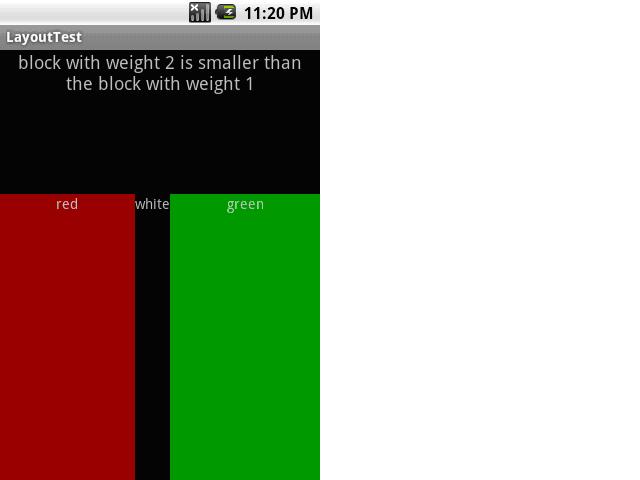|
LinearLayout:
LinearLayout是一个盒子模型(Box Model),以垂直或水平的方向,按照相对位置来排列所有的widgets或者其他的containers。所有被包含的widgets或者是containers都被堆放在container之后,因此一个垂直列表的每一行只会有一个widget或者是container,而不管他们有多宽,而一个水平列表将会只有一个行高(高度为最高子控件的高度加上边框高度)。LinearLayout保持其所包含的widget或者是container之间的间隔以及互相对齐(相对一个控件的右对齐、中间对齐或者左对齐)。 LinearLayout还支持为其包含的widget或者是container指定填充权值。好处就是允许其包含的widget或者是container可以填充屏幕上的剩余空间。这也避免了在一个大屏幕中,一串widgets或者是containers挤成一堆的情况,而是允许他们放大填充空白。剩余的空间会按这些widgets或者是containers指定的权值比例分配屏幕。默认的 weight 值为0,表示按照widgets或者是containers实际大小来显示,若高于0的值,则将Container剩余可用空间分割,分割大小具体取决于每一个widget或者是container的layout_weight及该权值在所有widgets或者是containers中的比例。例如,如果有三个文本框,其中两个指定的权值为1,那么,这两个文本框将等比例地放大,并填满剩余的空间,而第三个文本框不会放大,按实际大小来显示。如果前两个文本框的取值一个为2,一个为1,显示第三个文本框后剩余的空间的2/3给权值为2的,1/3大小给权值为1的。也就是权值越大,重要度越大。 如果LinearLayout包含子LinearLayout,子LinearLayout之间的权值越大的,重要度则越小。如果有LinearLayout A包含LinearLayout C,D,C的权值为2,D的权值为1,则屏幕的2/3空间分给权值为1的D,1/3分给权值为2的C。在LinearLayout嵌套的情况下,子LinearLayout必须要设置权值,否则默认的情况是未设置权值的子LinearLayout占据整个屏幕。 我们看一下效果图: <?xml version="1.0" encoding="utf-8"?> <LinearLayout xmlns:android="http://schemas.android.com/apk/res/android" android:orientation="vertical" android:layout_width="fill_parent" android:layout_height="fill_parent"> <LinearLayout android:id ="@+id/lineLayout1" android:orientation="vertical" android:layout_width="fill_parent" android:layout_height="fill_parent" android:layout_weight="2"> <!-如果未设置权值,则lineLayout1占据整个屏幕显示-> <TextView android:text="block with weight 2 is smaller than the block with weight 1" android:gravity="center_horizontal" android:textSize="8pt" android:layout_width="fill_parent" android:layout_height="wrap_content" /> </LinearLayout> <LinearLayout android:id ="@+id/lineLayout1" android:orientation="horizontal" android:layout_width="fill_parent" android:layout_height="fill_parent" android:layout_weight="1">
<TextView android:id = "@+id/red" android:text="red" android:gravity="center_horizontal" android:background="#aa0000" android:layout_width="wrap_content" android:layout_height="fill_parent" android:layout_weight="1"/> <TextView android:id = "@+id/white" android:text="white" android:gravity="center_horizontal" android:background="#000000" android:layout_width="wrap_content" android:layout_height="fill_parent" /> <TextView android:id = "@+id/green" android:text="green" android:gravity="center_horizontal" android:background="#00aa00" android:layout_width="wrap_content" android:layout_height="fill_parent" android:layout_weight="1"/> </LinearLayout> </LinearLayout> |
【转】LinearLayout:
2011-07-21
825
版权
版权声明:
本文内容由阿里云实名注册用户自发贡献,版权归原作者所有,阿里云开发者社区不拥有其著作权,亦不承担相应法律责任。具体规则请查看《
阿里云开发者社区用户服务协议》和
《阿里云开发者社区知识产权保护指引》。如果您发现本社区中有涉嫌抄袭的内容,填写
侵权投诉表单进行举报,一经查实,本社区将立刻删除涉嫌侵权内容。
简介:
LinearLayout:
LinearLayout是一个盒子模型(Box Model),以垂直或水平的方向,按照相对位置来排列所有的widgets或者其他的containers。所有被包含的widgets或者是containers都被堆放在container之后,因此一个垂直列表的每一行只会有一个widget或者是container,而不管他们有多宽,而一个水平列表将会只有一个行高(高度为最高子控件的高度加上边框高度)。
相关文章
|
算法
Java
Android开发
LinearLayout(线性布局)
本节开始讲Android中的布局,今天我们要讲解的就是第一个布局,LinearLayout(线性布局),我们屏幕适配的使用用的比较多的就是LinearLayout的weight(权重属性),在这一节里,我们会详细地解析LinearLayout,包括一些基本的属性,Weight属性的使用,以及比例如何计算,另外还会说下一个用的比较少的属性:android:divider绘制下划线!
50
0
0
|
容器
RelativeLayout(相对布局)
LinearLayout也是我们用的比较多的一个布局,我们更多的时候更钟情于他的weight(权重)属性,等比例划分,对屏幕适配还是帮助蛮大的;但是使用LinearLayout的时候也有一个问题,就是当界面比较复杂的时候,需要嵌套多层的LinearLayout,这样就会降低UI Render的效率(渲染速度),而且如果是listview或者GridView上的item,效率会更低,另外太多层LinearLayout嵌套会占用更多的系统资源,还有可能引发stackoverflow;但是如果我们使用RelativeLayout的话,可能仅仅需要一层就可以完成了,以父容器或者兄弟组件参考+margi
62
0
0
|
Android开发
|
XML
Android开发
数据格式
android 59 LinearLayout 线性布局
1073
0
0
|
Android开发
LinearLayout(线性布局)
1126
0
0
|
Android开发
android的LinearLayout布局
1006
0
0
|
XML
Android开发
数据格式
Android零基础入门第25节:最简单最常用的LinearLayout线性布局
原文:Android零基础入门第25节:最简单最常用的LinearLayout线性布局
良好的布局设计对于UI界面至关重要,在前面也简单介绍过,目前Android中的布局主要有6种,创建的布局文件默认为RelativeLayout相对布局,而在前面的示例学习中,我们只是简单利用了一下LinearLayout线性布局,那么接下来分别对其进行详细学习。
1257
0
0
|
XML
Android开发
数据格式
Android零基础入门第28节:轻松掌握RelativeLayout相对布局
原文:Android零基础入门第28节:轻松掌握RelativeLayout相对布局
在前面三期中我们对LinearLayout进行了详细的解析,LinearLayout也是我们用的比较多的一个布局。但在实际开发中使用LinearLayout远远不够,我们本期一起来学习RelativeLayout。
1223
0
0
|
Android开发
|
Android开发
容器
数据格式
Android学习笔记(11):线性布局LinearLayout
2156
0
0
热门文章
最新文章
1
理解事务的4种隔离级别
2
疑犯追踪第一季/全集Person Of Interest迅雷下载
3
简单实用的数据建模工具PDManer
4
详细讲解!Canal+Kafka实现MySQL与Redis数据同步!
5
71.7. Script for automatic startup on boot
6
关于Oracle客户端显示乱码问题
7
PHPWAMP站点管理的“域名模式”和“端口模式”详解、均支持自定义
8
jsHelper
9
学校里学不到的东西(一)
10
Python 3 教程一:入门
1
Python的装饰器
57
2
R语言用潜类别混合效应模型(Latent Class Mixed Model ,LCMM)分析老年痴呆年龄数据
48
3
数据分享|R语言用logistic逻辑回归和AFRIMA、ARIMA时间序列模型预测世界人口
50
4
【视频】马尔可夫链蒙特卡罗方法MCMC原理与R语言实现|数据分享(下)
45
5
【视频】马尔可夫链蒙特卡罗方法MCMC原理与R语言实现|数据分享(上)
62
6
数据分享|数据探索电商平台用户行为流失可视化分析
59
7
电商平台数据可视化分析网红零食销量
48
8
R语言线性回归模型拟合诊断异常值分析家庭燃气消耗量和卡路里实例带自测题
44
9
数据分享|R语言GLM广义线性模型:逻辑回归、泊松回归拟合小鼠临床试验数据(剂量和反应)示例和自测题
42
10
数据分享|R语言逻辑回归、线性判别分析LDA、GAM、MARS、KNN、QDA、决策树、随机森林、SVM分类葡萄酒交叉验证ROC(下)
58
